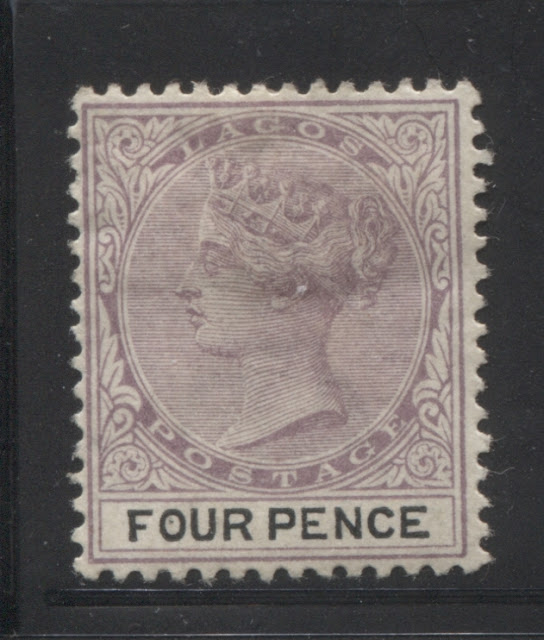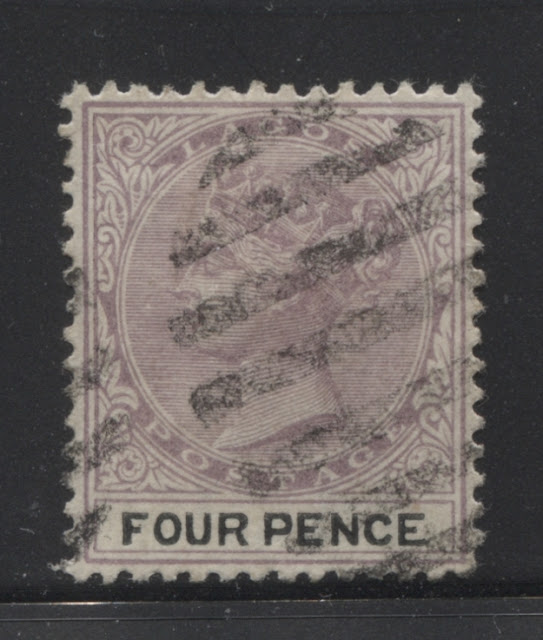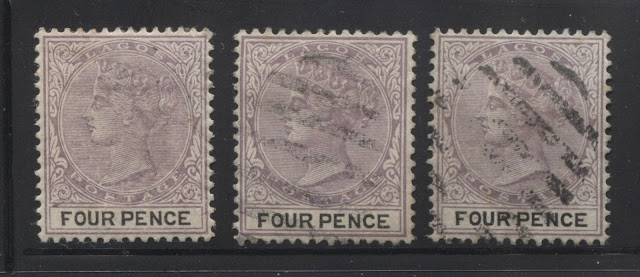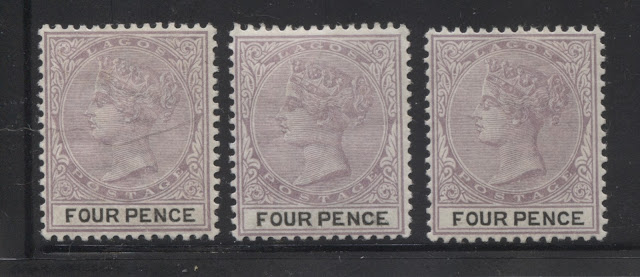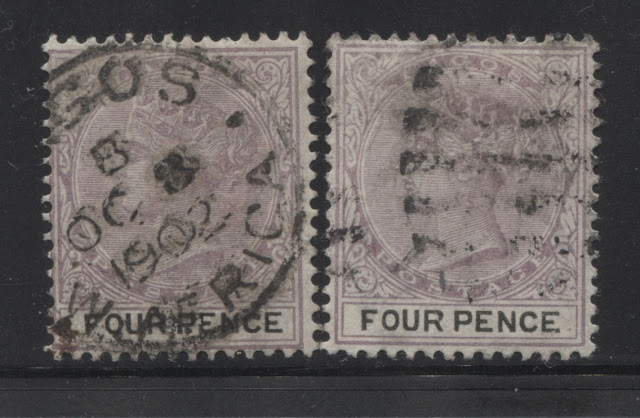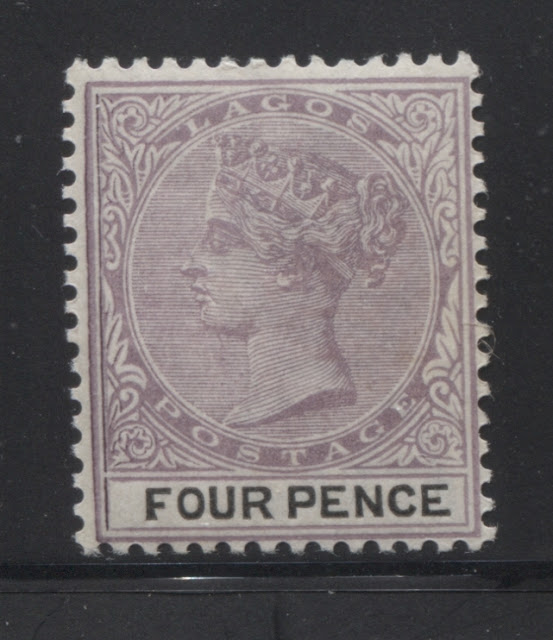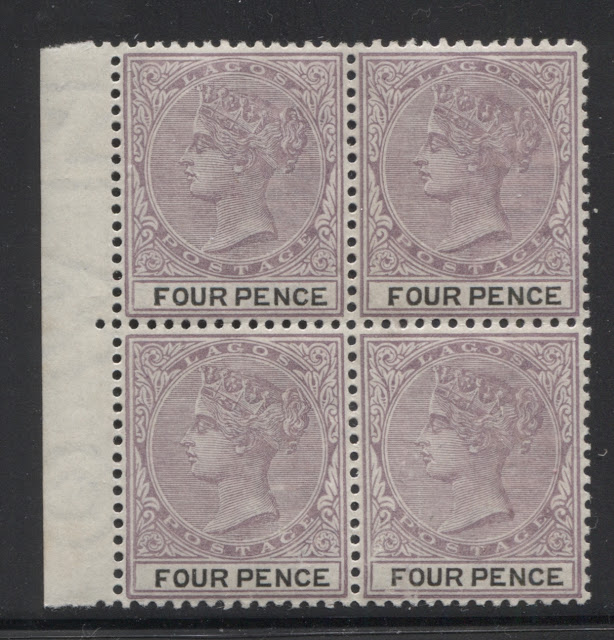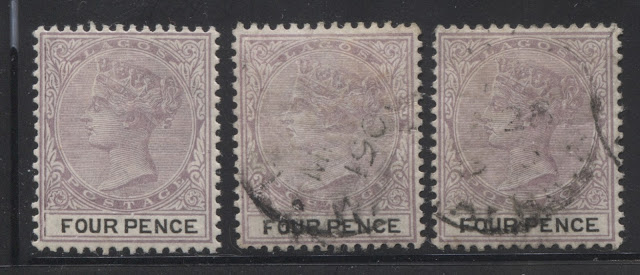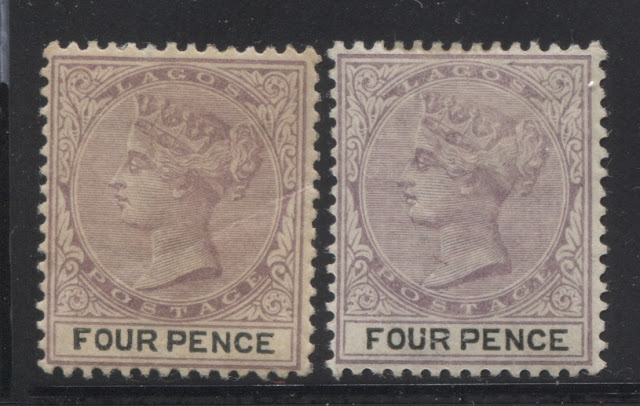In part two of this series of posts, I identified printings up to potentially 31 printings through about March 1895. Then I went through the various printings of the 1893 halfpenny surcharge that were made and attempted to tie those printings back to the unoverprinted stamps that I had already identified earlier. I was able to tie most of the surcharges back to a printing without surcharge. But I did wind up with a small handful of stamps with surcharge that did not tie back to anything that I had identified before. This suggests that either:
The colour of this printing is closest to Gibbons's lilac, but is just a bit paler and duller. It has a bluish undertone, so it is not a pale version of the reddish lilac, and it does not have the blackish undertone that the slate lilac has, so I would call this a dull lilac. I have three mint examples as shown above, and two used examples as shown below:
Fifty Second Printing (Now Determined to be the Forty Eighth Printing)
- These stamps represented additional printings that I did not have an example of without surcharge, or
- Some of the printings from the 4th and 5th states of the plate that I have not yet identified were actually made earlier than 1895 and would tie into these unidentified, surcharged stamps.
The second scenario is not very likely, but is possible. So the next logical step now is to put the surcharges aside for a moment and finish identifying the rest of the stamps without surcharge that I have, from states four and five of the plate, which cover the period from June/July 1895 through to August 1901.
However, in identifying the printings in groups 1-3 and going through my stamps, I overlooked 24 stamps that in retrospect should have been assigned to groups 2 and 3. It is possible that many of these stamps may match some of the printings that I already identified, and may not represent new printings. However, it is possible that these may be additional printings that will match some of those surcharged stamps that I was unable to assign to a printing made prior to March 1895. So before I look at the stamps from the fourth and fifth states, I need to look at these 24 stamps, which fell into eight groups. Until I can compare these 24 stamps to the printings already identified in groups 2 and 3, I will assume that these are all separate printings, which I will call printings 32 through 39.
Thirty Second Printing (Now Determined to be Another Example of the Thirteenth Printing)
The colour of this printing is a perfect match to Gibbons's reddish lilac. I have only the mint example shown above and no used examples.
Thirty Third Printing (Now Determined to be the Thirty Second Printing)
This printing is closest to Gibbons's reddish lilac also, but the colour is paler and milkier. I have only a single used example shown above, which is cancelled with a clear strike of an 8-bar oval obliterator.
Thirty Fourth Printing (Now Determined to be the Thirty Third Printing)
The colour of these three stamps is closest to Gibbons's slate lilac, but is quite a bit paler. However it lacks the reddish tone of the reddish lilac. I have a single mint example, as shown on the left, and two used examples. Both of these are cancelled with a clear strike of a 9-bar oval obliterator.
Thirty Fifth Printing (Now Determined to be the Twenty Seventh Printing)
This printing is closest to Gibbons's reddish lilac, but the colour is deeper than both the Gibbons swatch, at the stamp of the thirty second printing above. I have one single mint example shown at the left and two used examples. The middle stamp is cancelled with some kind of oval obliterator, though it is hard to tell whether or not it is an 8 bar or 9 bar obliterator. The stamp on the right is cancelled with the larger, wider Lagos CDS that was in use after 1903. This particular example is dated 1904, which suggests it is a very late use of an earlier printing that took place just before all unsold remainders were rounded up and sent back to London for destruction.
Thirty Sixth Printing (Now Determined to be the Thirty Fourth Printing)
The colour of this printing is closest to Gibbons's lilac, but is just a bit paler and duller. It has a bluish undertone, so it is not a pale version of the reddish lilac, and it does not have the blackish undertone that the slate lilac has, so I would call this a dull lilac. I have three mint examples as shown above, and two used examples as shown below:
The stamp on the right is cancelled with an oval obliterator, most likely an 8-bar oval. The left stamp is canceled with an October 8, 1902 Lagos CDS, which again would suggest a very late usage of an earlier printing, which is not unusual as we have seen.
Thirty Seventh Printing (Now Determined to be the Thirty Fifth Printing)
The colour of this printing is closest to the reddish lilac also, but the colour is just slightly duller than the Gibbons reddish lilac swatch. However, the overall tone is a perfect match. I have a single mint example as shown above, five used examples as shown below, and a mint marginal block shown below that:
All of the used examples shown here, except the second one are cancelled with either 8 or 9 bar oval obliterators. It is difficult to make them out exactly, but the first and fourth stamps appear to be 8-bars, while the third and fifth appear to be 9-bar obliterators. The second stamp is cancelled with an indistinct CDS, most likely Lagos.
The mint block of four, shown below, from the left side of the sheet, showing the Crown Agent's watermark in the left selvage, matches both the shade and plate characteristics of the stamps in this group. Therefore, I have ascribed this block to the thirty seventh printing.
The first used stamp in this group shows a clear break in the outer circular frame under the "A" of "Postage". This break is likely constant, though further research would be required to prove this. Although the stamp does have some minor surface scuffing, there is no trace of any colour in the area around the break, nor is there any apparent surface damage to the paper where the break is seen. This suggests that it is a genuine variety and not the result of a scuff:
Thirty Eighth Printing (Now Determined to be the Twenty Sixth Printing)
The colour of this printing is again closest to the reddish lilac, but is duller. Therefore I would call this dull reddish lilac. I have one single mint example as shown at left, and two used used examples, both cancelled with Lagos CDS's. The middle stamp is dated sometime in May 1901, but I cannot quite make out the date on the other one. Again, this appears to be a late usage of an earlier printing.
Thirty Ninth Printing (Now Determined to be the Twenty First Printing)
The stamp on the left has been affected by the aging of the paper which has come about because of the gum, giving it a more yellowish appearance. However, I believe that its true colour is the same as the stamp on the right. The colour of this printing is closest to the Gibbons's dull purple, but is much paler. It is too dull to be a match to any of the lilac swatches.
I have only two mint examples shown above and no used examples.
Group 4 - Printings 40-50 Made From the Fourth State of the Plate - June/July 1895 or Possibly October 1897 to April 1900. (Now Determined to be Printings 36-46)
In this state, the detail in the hair at the back of the head is completely gone, both below the diagonal ribbon at the back of the head and above it as well. The hairlines at the top of the head and near the jewels of the crown have fused together so that only a narrow band of hair detail in the middle of the head is visible. The horizontal shading lines in the band of the crown have begun to merge together and the horizontal background lines of the medallion have begun to wear, causing them to become thicker in places and consequently, closer to their neighbours.
This group begins sometime between June or July 1895 and October 1897, depending on how many of the 24 stamps that I just identified as being earlier printings are actually separate printings from those already identified. If they are all separate printings, then the period covered by this group would not start until October 1897, approximately.
Fortieth Printing (Now Determined to be the Thirty Sixth Printing)
The colour of this printing is closest to bright lilac, but is a little duller. It is definitely much brighter than the reddish lilac swatch. My single used example shown here is canceled with an 8-bar oval obliterator.
Forty First Printing (Now Determined to be the Thirty Seventh Printing)
The colour of this printing is closest to Gibbons's slate lilac, but the colour is just a bit paler. Again, I have no mint examples of this printing, but just this used stamp, which appears to have been cancelled with an 8-bar oval obliterator.
Forty Second Printing (Now Determined to be the Thirty Eighth Printing)
The colour of this printing is closest to Gibbons's dull mauve, but the colour is a bit rosier than the Gibbons swatch. However the overall intensity of the colour is a perfect match. I have no mint examples of this printing, and just the two used examples shown above. So it is possible that these are just faded through exposure to water. A mint example matched to these two stamps would establish that these are indeed the original colour. Both these stamps are cancelled with strikes of a 9-bar oval obliterator.
Forty Third Printing (Now Determined to be the Thirty Ninth Printing)
The colour of this printing is closest to Gibbons's reddish lilac, but the colour is much deeper. It is not deep enough to be the slate lilac, but is a deep reddish lilac.
I have no used examples of this printing, but only the three mint examples shown above.
Forty Fourth Printing (Now Determined to be the Fortieth Printing)
The colour of this printing is closest to Gibbons's lilac, but is deeper than the colour swatch for lilac shows. The bluish undertone however is a match and thus calling this a deep lilac would seem to be appropriate.
I have two mint examples and two used. The cancel on the right stamp is indistinct, but the used stamp on the left is cancelled with a clear 9-bar oval obliterator.
Forty Fifth Printing (Now Determined to be the Forty First Printing)
This is another stamp whose colour is a deep version of the reddish lilac. This one though is more reddish than the stamps of the forty third printing, and is thus an almost perfect match to the Gibbons swatch for reddish lilac. It is just a touch deeper.
I have no mint examples, and only the used example shown here. It appears to have been canceled with a strike of a 9-bar oval obliterator.
Forty Sixth Printing (Now Determined to be the Forty Second Printing)
This printing is closest to deep lilac, very similar to the forty fourth printing. However, this one is just a little bit rosier, but not reddish enough to be a match for the reddish lilac. I have one single mint example shown at the left, and once smudgy CDS used example at the right.
Forty Seventh Printing (Now Determined to be the Forty Third Printing)
This printing is closest in colour to the dull purple, in terms of tone, but the colour is much, much paler than the Gibbons swatch for dull purple. It is loosely similar to the grey-lilac swatch, but it is not quite bluish enough to be a match for that shade. So I am going to say that this is pale dull purple. I have one mint example as shown at the left, and one used example as shown at right.
The used stamp of this printing shows another constant plate flaw, this time consisting of a break in the bottom of the ornaments in the lower left spandrel, just above the "E" of "Pence". An enlarged scan shows the break very clearly:
Forty Eighth Printing (Now Determined to be the Forty Fourth Printing)
The colour of this printing is closest to Gibbons's slate lilac, but much paler. I have only the mint example shown above.
Forty Ninth Printing (Now Determined to be the Forty Fifth Printing)
This printing is also closest in tone to Gibbons's slate lilac, but it is both paler and duller. I have four mint examples and one used example. The used example is canceled with a barred oval obliterator. I can't be completely sure, but it looks like a 9-bar oval, from the narrow width of the bars.
Fiftieth Printing (Now Determined to be the Forty Sixth Printing)
The shade of this printing is almost identical to the last - a pale and dull slate lilac. The impression of this printing overall is coarser than the 49th printing, so I have assigned this to a separate printing. I have no used examples, but just a single mint example as shown above.
Group 5 - Printings 51 to 56 Made From the Fifth State of the Plate - April 1900 to August 1901 (Now determined to be Printings 47-52)
In this fifth and final state of the plate, almost all of the detail in the hair is gone. Most of the lines in the band of the crown have merged together, and the horizontal shading lines of the medallion are of uneven thickness.
Fifty First Printing (Now Determined to be the Forty Seventh Printing)
The shade of this printing is also closest to a pale and dull slate lilac, although the colour of this printing does contain just a touch more rose. I have seven mint examples as shown below and no used examples at all. This suggests that this might well be one of the last printings received, that would have been very heavily remaindered.
Fifty Second Printing (Now Determined to be the Forty Eighth Printing)
The shade of this printing is very distinct, being an almost perfect match to Gibbons's grey lilac. It is the only one of the printings identified so far to be printed in this shade, which completely lacks any reddish undertone.
Fifty Third Printing (Now Determined to be the Forty Ninth Printing)
The shade of this printing is about mid way between the Gibbons slate lilac and Gibbons reddish lilac. If you can imagine combining these two swatches into one colour, this is the colour that I believe you would get.
As expected of these last printings, both of the examples that I have are mint.
Fifty Fourth Printing (Now Determined to be the Fiftieth Printing)
This printing is closest in shade to Gibbons's slate lilac, but this shade is just a touch duller, but of the same overall intensity. Again, I have only the single mint example shown.
Fifty Fifth Printing (Now Determined to be the Fifty First Printing)
This is an almost perfect match to Gibbons's reddish lilac, but is just a bit deeper. Again, I have no used examples, but just have the mint example shown above.
Fifty Sixth Printing (Now Determined to be the Fifty Second Printing)
The colour of this printing is closest to Gibbons's lilac, but just a little bit deeper. It is one of the few stamps from this last group of printings that I have a used example of, and this one is cancelled with a beautiful socked-on-the-nose August 21, 1899 Abeokuta CDS cancel.
This concludes my identification of the remaining printings of the 4d lilac and black stamp. The next logical step will be to attempt to match the 24 stamps from printings 32 through 40 to one of the printings already identified for both the regular 4d stamps, and those examples of the halfpenny surcharge that I was not yet able to match to any printing. This will be the subject of next week's post.


